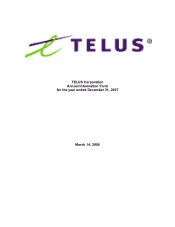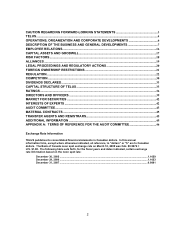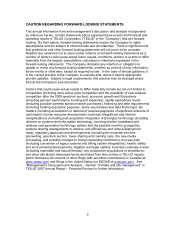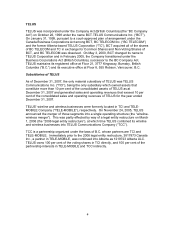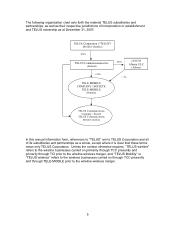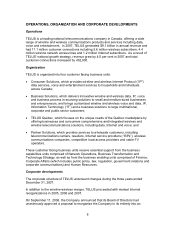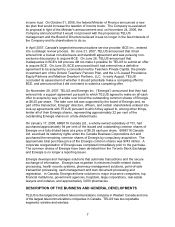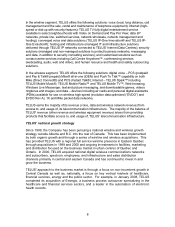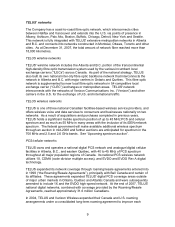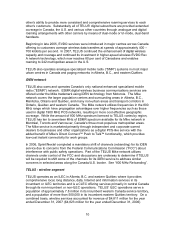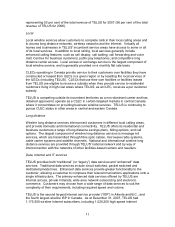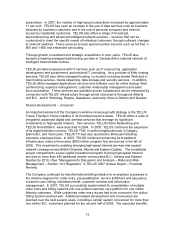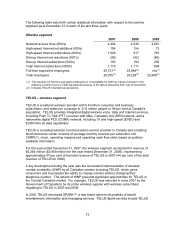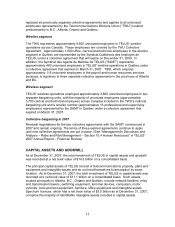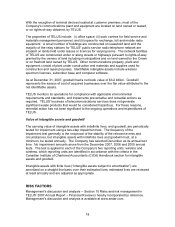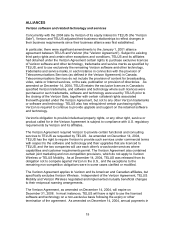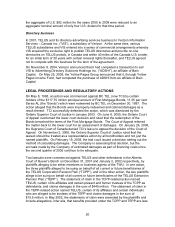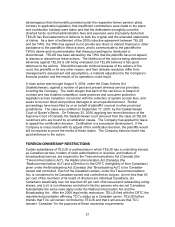Telus 2007 Annual Report Download - page 11
Download and view the complete annual report
Please find page 11 of the 2007 Telus annual report below. You can navigate through the pages in the report by either clicking on the pages listed below, or by using the keyword search tool below to find specific information within the annual report. 11
representing 53 per cent of the total revenue of TELUS for 2007 (56 per cent of the total
revenue of TELUS for 2006).
Local
Local wireline services allow customers to complete calls in their local calling areas and
to access long distance networks, wireless networks and the Internet. Virtually all
homes and businesses in TELUS’ incumbent service areas have access to some or all
of its local services. In addition to local calling, local services generally include
enhanced calling features, such as call display, call waiting, call forwarding and voice
mail; Centrex for business customers; public pay telephones; and competitive long
distance carrier access. Local access or exchange service is the largest component of
local wireline service, and is generally provided on a monthly flat rate basis.
CLECs operating in Canada provide service to their customers over facilities they have
constructed or leased from ILECs in a given region or by reselling the local services of
the ILECs (including TELUS). CLECs that use their own facilities or facilities leased
from TELUS are eligible to receive a subsidy when they provide service to residential
customers living in high cost areas where TELUS, as an ILEC, receives a per customer
subsidy.
TELUS is competing outside its incumbent territories as a non-dominant carrier and has
obtained approval to operate as a CLEC in certain targeted markets in central Canada
where it concentrates on providing business wireline services. TELUS is continuing to
pursue CLEC status in other areas in central and eastern Canada.
Long distance
Wireline long distance services interconnect customers in different local calling areas,
and provide domestic and international connectivity. TELUS offers its residential and
business customers a range of long distance savings plans, billing options, and call
options. The largest component of wireline long distance services is message toll
services, which are transmitted through fibre optic cables, microwave radio systems,
cable carrier systems and satellite channels. National and international wireline long
distance services are provided through TELUS’ national network and by way of
interconnection with the networks of other facilities-based carriers and resellers.
Data, Internet and IT services
TELUS provides both “traditional” (or “legacy”) data services and “enhanced” data
services. Traditional data services include circuit switched, packet switched and
dedicated private lines. Enhanced data services provide greater functionality to the
customer, allowing a customer to compress their telecommunications applications onto a
single infrastructure. The primary enhanced data services offered by TELUS are
Internet access, private Intranets, wide area network outsourcing and electronic
commerce. Customers may choose from a wide range of data services to suit the
complexity of their requirements, including required speed and volume.
TELUS is the second largest Internet service provider (“ISP”) in Alberta and B.C., and
the fourth largest wireline ISP in Canada. As at December 31, 2007, TELUS had
1,175,500 wireline Internet subscribers, including 1,020,200 high-speed Internet

